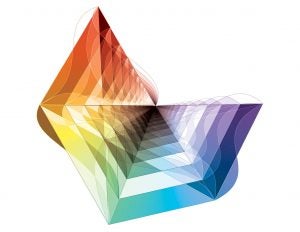Scattering amplitudes are fundamental objects in any quantum field theory. They describe probabilities of interactions of elementary particles. The standard method to calculate amplitudes is using Lagrangians and Feynman diagrams. This universal method suffers from huge redundancies when applied in gauge theories in gravity. In the modern powerful approaches like unitarity methods or recursion relations these redundancies are absent. In last few years there has been an increasing number of evidence that there exist a completely new formulation of physics using abstract mathematical objects. In the case of maximally supersymmetric Yang-Mills theory in planar limit it was showed that scattering amplitudes can be calculated of volumes of polytopes in abstract high dimensional spaces. The physical principles like unitarity and locality are derived from the underlying geometry. This discovery can shed new light on perturbation theory, and it might possibly lead to new more geometric reformulation of quantum field theory.
For a complete list of my papers see the INSPIRE link.
Recent discoveries
In 2012 we published a long paper on the relation between scattering amplitudes in planar N=4 SYM and positive Grassmannian. In this paper we defined new set of kinematical functions, on-shell diagra ms, and we showed that cuts of the amplitude as well as the recursion relations can be formulated in this language. The surprising part was the connection between these objects with the cells in the positive Grassmannian and permutations. In addition to being a fascinating connection it also proved that all singularities of amplitudes are logarithmic.
ms, and we showed that cuts of the amplitude as well as the recursion relations can be formulated in this language. The surprising part was the connection between these objects with the cells in the positive Grassmannian and permutations. In addition to being a fascinating connection it also proved that all singularities of amplitudes are logarithmic.
One year later, we found that this picture can be further generalized and the amplitudes can be calculated as volumes of Amplituhedron which is a generalization of the positive Grassmanian, not yet studied by mathematicians. This step removed rest of the physical intuition and defined the amplitude in abstract mathematical terms.
I have been also looking for non-planar generalization of these structures. We showed that for MHV helicity case the non-planar on-shell diagrams have very nice properties. The amplitudes also share many of the features of their planar counterparts, in particular we conjectured they have logarithmic singularities and no poles at infinity, which was checked up to three-loops. In addition, we also gave an evidence that the Amplituhedron-like structure might be present there as well.
In last years, we collected even more evidence that the geometric picture extends to other cases as well. In particular, we found the Grassmannian formulation for gravity on-shell diagrams and also showed that the positivity property of the Amplituhedron conjectured for the integrand is present for the final IR finite combinations of amplitudes.
I also worked on the new methods how to calculate amplitudes in effective field theories. In particular, we showed that imposing soft limit behavior of scattering amplitudes fixes completely certain scalar effective field theories and we formulated new recursion relations in this context. Recently, we also applied this method to vector theories.